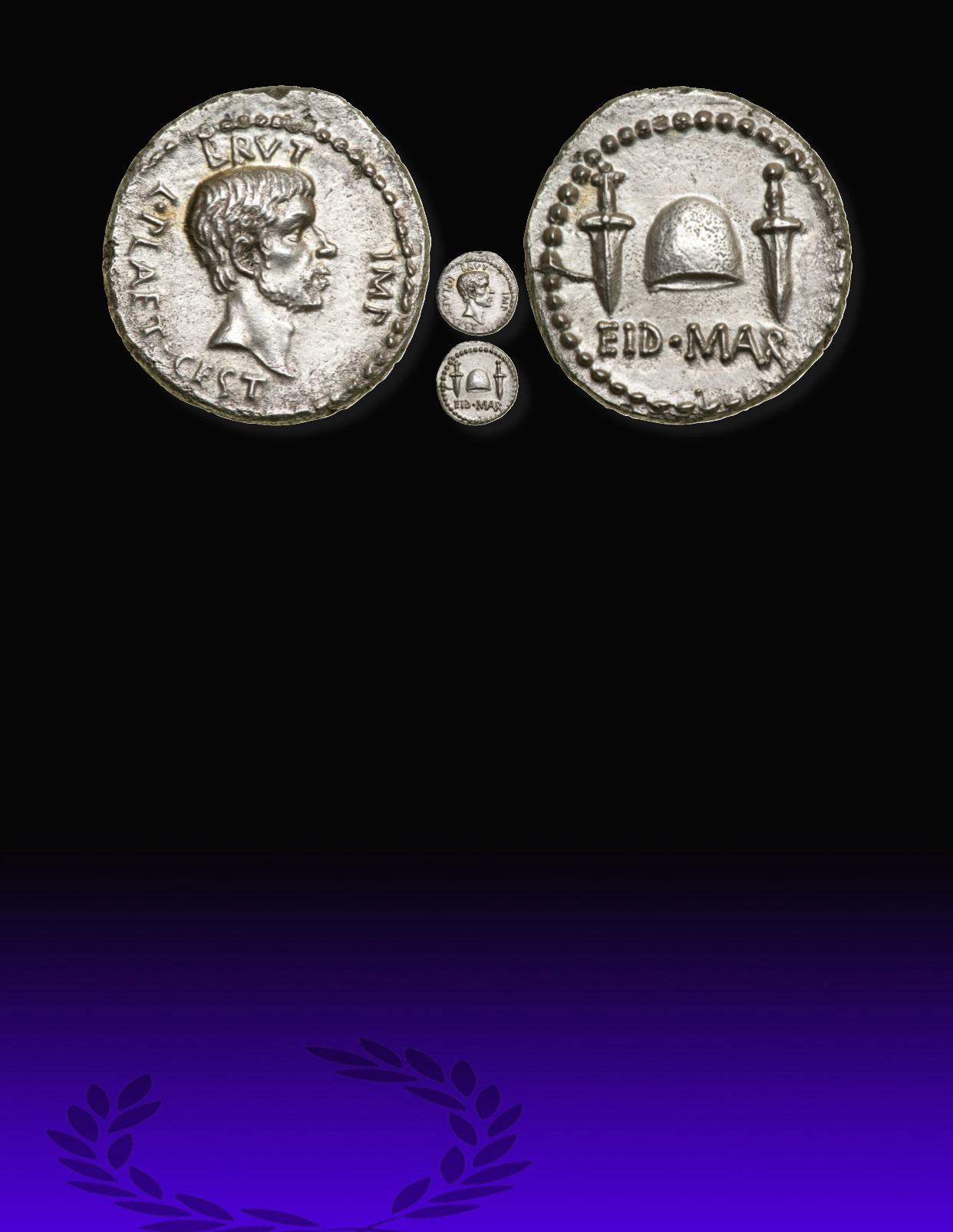
73
3089
Brutus. Silver Denarius (3.52 g), 42 BC.
Mint moving with Brutus in northern Greece. L. Plaetorius Cestianus, magistrate. BRVT above,
IMP before, L PLAET CEST behind, bare head of Brutus right.
Reverse:
EID MAR, pileus between two daggers. Crawford 508/3; Cahn
13b; HCRI 216; Sydenham 1301; Mazzini pl. V, 15 (same dies); Naville XV, 1315 (same dies); RSC 15. An incredible example in outstand-
ing condition for this issue of great historical importance. Boldly struck with an incredible, well defined portrait on a full broad flan with
minor porosity, all lightly toned. The ultra important reverse is simply breathtaking!
Among the finest known examples
.
Superb Extremely
Fine.
The highly provocative design of the reverse of this most famous of Roman coins, the Eid Mar denarius, presents us with the fait accom-
pli of Caesar’s assassins. The coin loudly proclaims that the hated tyrant is dead and that the deed was done in the name of liberty.
On the Ides of March 44 BC, M. Junius Brutus and C. Cassius Longinus led a host of other senators to rid Rome of Julius Caesar.
Caesar had been proclaimed dictator for life and held absolute power, holding all of Rome’s top offices. Many felt he aspired to
become king. Not only did he already have all the powers of an absolute monarch, just three months prior to his assassination he
committed his most egregious affront to Roman sensibilities when usurped the royal prerogative of placing his own image on the
coinage. Never before had a living Roman’s portrait appeared on the coinage, and in the minds of the conspirators this must have
been the final straw, the fatal coalescing of all their enmity. Caesar paid with his life, and the fabric of the Republic was torn asunder.
It took time after Caesar’s assassination for the situation to develop to the point of open civil war. At first, Antony as leader of
the Senate proclaimed a general amnesty for the conspirators, but after the establishment of the Second Triumvirate between
Octavian, Mark Antony and Lepidus in November 43 BC, the conspirators were declared public enemies. Being the lead-
ers of the conspiracy to assassinate Caesar, Brutus and Cassius had long before fled Rome, their safety at risk from the Ro-
man mob. In early 42 BC, however, they joined forces at Sardes in Asia Minor and began preparations for the final show-
down with the triumvirs. By the summer they were in Macedonia en route to engage the forces of Antony and Octavian.
The first battle of Philippi took place to the west of the town on October 3. Brutus faced Octavian while Cassius engaged Ant-
ony. Brutus successfully pushed back the forces of Octavian, but those of Cassius were routed by Antony, and on hear-
ing a false report that Brutus had been defeated and killed, Cassius committed suicide. The second battle took place
on October 23 and saw the combined forces of the conspirators under the sole command of Brutus. They proved no
match for the triumvirs, however, and Brutus was soundly defeated. Seeing that all was lost, he too committed suicide.
The Eid Mar denarius was struck to pay Brutus’ troops and campaign expenses. His choice of types are both appropriate on the one
hand and ironic on the other. The reverse depicts the pileus, or cap of liberty traditionally given to slaves when they were freed,
between the daggers representing the death of Caesar, while the legend EID MAR records the date the Republic was released from
Caesar’s tyranny. The message is unequivocal and follows the long Roman tradition of proclaiming illustrious events of one’s family on
the coinage. Of course, what was more important for Brutus than his own involvement in the restoration of the Republic by ridding it of
Caesar? The obverse is different, however. If the appearance of Caesar’s portrait on coinage was the final straw that precipitated the
actions of the conspirators, then surely it would be improper (ironic even) for Brutus to place his own portrait on his coins. However, by this
time the triumvirs were already placing their own portraits on coins (see Crawford 494), and Brutus was merely following their footsteps.
Estimated Value ................................................................................................................................................................................ $250,000-UP
Ex. Private purchase from Freemnan and Sear, 2009


